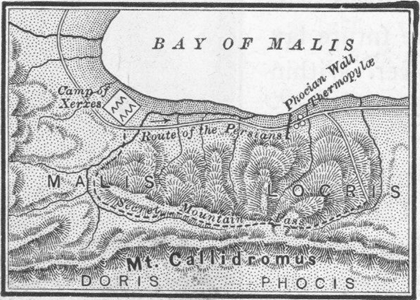Pass of Thermopylae, Greece: At the time of Leonidas the pass was a path under the cliff about 40 feet wide. The famous Battle of Thermopylae pitted the Persians against the 300 Spartans. This battle, which resulted in a Persian victory, took place in 480 B.C.E. Greek leaders: Leonidas I and Demophilus. Persian leaders: Xerxes I of Persia, Hydarnes, and Mardonius. As a result of this battle, Persians gained control over Boeotia and were placed to march toward Athens. Click here to enlarge.
 The Battle of Thermopylae, fought in 480 B.C.E., was a famous engagement during the Greco-Persian Wars. It is best known for the heroic defense of the Greek forces, primarily a small contingent of Spartans led by King Leonidas, against the much larger Persian army led by King Xerxes I.
The Battle of Thermopylae, fought in 480 B.C.E., was a famous engagement during the Greco-Persian Wars. It is best known for the heroic defense of the Greek forces, primarily a small contingent of Spartans led by King Leonidas, against the much larger Persian army led by King Xerxes I.
Background: The conflict was part of the larger Greco-Persian Wars, a series of battles and campaigns between the Greek city-states and the Persian Empire. King Xerxes I of Persia sought to expand his empire into Greece.
Key Participants:
- Greeks: The Greek forces, led by King Leonidas I of Sparta, included a small number of Spartans along with allies from other Greek city-states. The Spartans were renowned for their military prowess.
- Persians: The Persian army, led by King Xerxes I, consisted of a massive force drawn from various parts of the empire.
Battle Details:
- Location: The battle took place at the narrow coastal pass of Thermopylae in central Greece. The location favored the defenders, as it limited the advantage of the larger Persian army.
- Greek Strategy: The Greeks, led by King Leonidas, chose to defend the narrow pass at Thermopylae, which was only a few meters wide. This created a bottleneck that would minimize the Persians' numerical advantage.
- Spartan Phalanx: The Spartans formed a formidable hoplite phalanx, a tight infantry formation composed of heavily armored soldiers with long spears and shields. They were positioned at the front of the Greek line.
- Initial Skirmishes: The battle began with several days of skirmishes and minor engagements. The Spartans and their allies held their ground and repelled Persian attacks.
- Traitor's Path: A local resident named Ephialtes betrayed the Greeks by revealing a mountain path that could be used to encircle and outflank them. This path allowed Persian troops to get behind the Greek position.
- Last Stand: As the Persian forces began to encircle them, King Leonidas and his 300 Spartan warriors, along with a few hundred other Greek soldiers, chose to make a heroic last stand. They fought to the death, inflicting heavy casualties on the Persians.
Aftermath:
- Symbol of Heroism: The Battle of Thermopylae has become a symbol of heroism and sacrifice. The small Greek force's willingness to stand and fight against overwhelming odds has inspired countless stories, art, and literature.
- Strategic Significance: Although the Greeks lost the battle, their resistance at Thermopylae delayed the Persian advance and allowed the Greek city-states more time to prepare for the larger battles of the Greco-Persian Wars.
- Continuation of the Wars: The Greco-Persian Wars continued with further battles, including the naval Battle of Salamis and the decisive Battle of Plataea, which ultimately led to a Greek victory and the repulsion of the Persian invasion.
The Battle of Thermopylae remains a legendary event in history, celebrated for the bravery and determination of the Greek soldiers, particularly the Spartans, in the face of overwhelming odds. It is an enduring symbol of the indomitable spirit of defenders in the face of aggression.
|
 The Battle of Thermopylae, fought in 480 B.C.E., was a famous engagement during the Greco-Persian Wars. It is best known for the heroic defense of the Greek forces, primarily a small contingent of Spartans led by King Leonidas, against the much larger Persian army led by King Xerxes I.
The Battle of Thermopylae, fought in 480 B.C.E., was a famous engagement during the Greco-Persian Wars. It is best known for the heroic defense of the Greek forces, primarily a small contingent of Spartans led by King Leonidas, against the much larger Persian army led by King Xerxes I.












